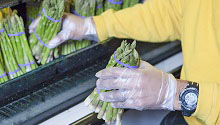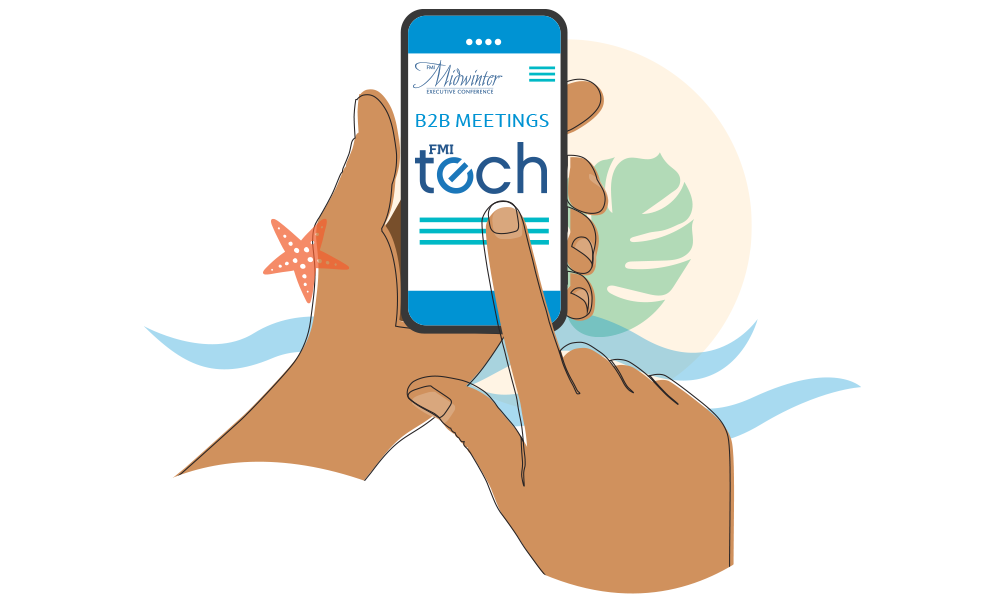By: Rick Stein, Vice President, Fresh Foods, FMI and Steve Markenson, Director, Research, FMI
 There was something exciting about the way things used to be at the grocery deli. Before the COVID-19 pandemic upended the established rhythm and routine of society, throngs of familiar faces would form queues in the deli section, waiting to tear off a ticket that would put them in a lineup to order the week’s lunch and dinner options. As customers waited, their eyes would thoroughly scan the hot food case, sparking an internal debate over whether to add a bag of glistening baked or crackling fried chicken to their carriage. Of course, my favorite was always the mac and cheese. The children would naturally gravitate to the swirling pizza case, where curious eyes would fixate on the crispy pepperoni, sausages or vegetables seamlessly infused with the top layer of melty cheese. All the while, associates would be calling out numbers to summon the next customer to the front. “How can I help you?” or “What’s on the menu for this week?” were common refrains from the friendly employees behind the counter who somehow always knew how to prepare your order just right. The exchanged “thank you” and “your welcome” following the handoff of your grocery deli-prepared items came with a slight spark of satisfaction, like a high-five after a brief moment of teamwork. I and my colleague Steve know this experience by heart and cherish the interactions that accompany in-person ordering of fresh foods. But increasingly, newer generations are opting for a tech- and convenience-driven approach.
There was something exciting about the way things used to be at the grocery deli. Before the COVID-19 pandemic upended the established rhythm and routine of society, throngs of familiar faces would form queues in the deli section, waiting to tear off a ticket that would put them in a lineup to order the week’s lunch and dinner options. As customers waited, their eyes would thoroughly scan the hot food case, sparking an internal debate over whether to add a bag of glistening baked or crackling fried chicken to their carriage. Of course, my favorite was always the mac and cheese. The children would naturally gravitate to the swirling pizza case, where curious eyes would fixate on the crispy pepperoni, sausages or vegetables seamlessly infused with the top layer of melty cheese. All the while, associates would be calling out numbers to summon the next customer to the front. “How can I help you?” or “What’s on the menu for this week?” were common refrains from the friendly employees behind the counter who somehow always knew how to prepare your order just right. The exchanged “thank you” and “your welcome” following the handoff of your grocery deli-prepared items came with a slight spark of satisfaction, like a high-five after a brief moment of teamwork. I and my colleague Steve know this experience by heart and cherish the interactions that accompany in-person ordering of fresh foods. But increasingly, newer generations are opting for a tech- and convenience-driven approach.
According to The Power of Foodservice at Retail 2021 report, 89% of Baby Boomers prefer ordering from a person, while Millennials and Gen Z prefer using their smartphones or a kiosk. In fact, only 20% of Gen Z and 23% of Millennials prefer ordering from a person. Meeting younger consumers where they are means offering greater clarity on prices and meal deals, as well as insights on delivery times, wait times, promotions, and the ability to customize orders. That’s why apps like DoorDash and Uber Eats have become a highly popular medium through which COVID-cautious consumers can get their favorite meals delivered in a punctual and safe manner.
Opportunity is ripe for foodservice at retail to capitalize on this new trend. After all, 62% of consumers would use a specific foodservice app from their grocery store. Currently, though, only about one-third have ordered grocery deli-prepared foods for pickup and delivery, respectively. This reality puts greater impetus on food retailers to leverage ecommerce as a means to drive foodservice sales and customer satisfaction.
It might not be the tried-and-true ticket tearing of the past, but it’s what an ever-growing number of consumers are calling for. To learn more about the technological potential of foodservice at retail, check out A FreshForward Conversation With Katie Ceclan of Albertsons: What’s Ahead for Ecommerce and Fresh. You can keep up with our FreshForward Conversation series at FMI.org/FreshForward. Also, get the big picture on future-focused foodservice by joining FMI’s Oct. 7 webinar, The Power of Foodservice at Retail 2021.
-
Industry Topics
- Asset Protection
- Biotechnology
- Corporate Social Responsibility
- Crisis Management
- Diversity, Equity & Inclusion
- Food Assistance Programs
- Food Price Inflation
- Fresh Foods
- Frozen Foods
- Health & Well-being
- Independent Operator
- Labeling
- Labor & Employment
- Nonfoods
- Omnichannel
- Payments
- Pharmacy
- Private Brands
- Supplier Diversity
- Supply Chain
- Technology
- Total Store Collaboration
- Wholesaler
- Workforce & Talent
- Research & Insights
- Events & Education
- Food Safety
- Government Affairs
- Get Involved
Related Posts
-
Why You Should Experience the Power of Meat 2025 Live and In-Person
What sets thriving meat industry businesses apart? It’s staying ahead of trends, understanding consumer shifts early, and connecting with industry leaders. As the Power of Meat marks its 20th anniversary, the value of live insights and real-time discussions has never been clearer. Attendees at the Annual Meat Conference (AMC), March 24-26, 2025, in Orlando will be the first to access the highly anticipated report, gaining exclusive insights before anyone else. Last year’s report was impactful, but there’s no substitute for experiencing this milestone event in person. Here’s why you can’t miss it.
-
Embracing the Future: FMI's Technology Initiatives for Q1 2025
At the doorstep of 2025, the scale of FMI's technology projects is truly remarkable, reflecting how technology continues to reshape grocery retail. Key initiatives for Q1 2025 focus on critical industry shifts and opportunities.
Mega Menu
 Industry Topics address your specific area of expertise with resources, reports, events and more.
Industry Topics address your specific area of expertise with resources, reports, events and more.
 Our Research covers consumer behavior and retail operation benchmarks so you can make informed business decisions.
Our Research covers consumer behavior and retail operation benchmarks so you can make informed business decisions.
 Events and Education including online and in-person help you advance your food retail career.
Events and Education including online and in-person help you advance your food retail career.
 Food Safety training, resources and guidance that help you create a company food safety culture.
Food Safety training, resources and guidance that help you create a company food safety culture.
 Government Affairs work — federal and state — on the latest food industry policy, regulatory and legislative issues.
Government Affairs work — federal and state — on the latest food industry policy, regulatory and legislative issues.
 Get Involved. From industry awards to newsletters and committees, these resources help you take advantage of your membership.
Get Involved. From industry awards to newsletters and committees, these resources help you take advantage of your membership.
 Best practices, guidance documents, infographics, signage and more for the food industry on the COVID-19 pandemic.
Best practices, guidance documents, infographics, signage and more for the food industry on the COVID-19 pandemic.
© FMI All rights reserved.
Website design by Matrix Group International, Inc. ®
-
fmi-icon-frozen-goods
-
fmi-icon-workforce
-
fmi-icon-certificate
-
fmi-icon-pharmacy
-
fmi-icon-food-safety
-
fmi-icon-asset-protection
-
fmi-icon-education force-icon-3
-
fmi-icon-research
-
fmi-icon-government-affairs
-
fmi-icon-get-involved
-
fmi-icon-industry-topic force-icon-3
-
fmi-icon-labeling
-
fmi-icon-corporate-social-responsibility
-
fmi-icon-payments
-
fmi-icon-crisis-management
-
fmi-icon-private-brands
-
fmi-icon-food-assistance
-
fmi-icon-supplier-diversity
-
fmi-icon-fresh-foods
-
fmi-icon-supply-chain
-
fmi-icon-general-merchandise
-
fmi-icon-technology
-
fmi-icon-health-wellness
-
fmi-icon-total-store-collaboration
-
fmi-icon-Health-Reform
-
fmi-icon-wage-labor
-
fmi-icon-independent-operator
-
fmi-icon-wholesaler-topic
-
fmi-icon-newsroom force-icon-3
-
fmi-icon-tax-reform
-
fmi-icon-about_icon force-icon-4
-
fmi-icon-about_icon
-
fmi-icon-cart
-
fmi-icon-blog_icon force-icon-5
-
fmi-icon-cart
-
fmi-icon-Communications
-
fmi-icon-omnichannel
-
fmi-icon-biotechnology-topic


